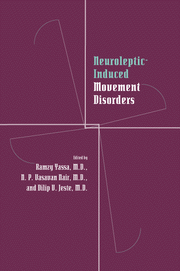Book contents
- Frontmatter
- Contents
- Contributors
- Preface
- Part I Historical perspective
- Part II Clinical aspects of tardive dyskinesia
- 2 Aging and tardive dyskinesia
- 3 Gender as a factor in the development of tardive dyskinesia
- 4 The Yale tardive dyskinesia study: a prospective incidence study among long-term outpatients
- 5 Vulnerability to tardive dyskinesia in schizophrenia: an exploration of individual patient factors
- 6 Tardive dyskinesia and affective disorder
- 7 Diabetes mellitus and tardive dyskinesia
- 8 Other factors in the development of tardive dyskinesia
- 9 Neuroleptic treatment and tardive dyskinesia
- 10 Anticholinergic drugs as factors in the development of tardive dyskinesia
- Part III Mechanisms underlying tardive dyskinesia
- Part IV Measurement of tardive dyskinesia
- Part V Tardive dyskinesia in different populations
- Part VI Other neuroleptic-induced movement disorders
- Part VII Treatment of tardive dyskinesia
- Index
4 - The Yale tardive dyskinesia study: a prospective incidence study among long-term outpatients
from Part II - Clinical aspects of tardive dyskinesia
Published online by Cambridge University Press: 09 October 2009
- Frontmatter
- Contents
- Contributors
- Preface
- Part I Historical perspective
- Part II Clinical aspects of tardive dyskinesia
- 2 Aging and tardive dyskinesia
- 3 Gender as a factor in the development of tardive dyskinesia
- 4 The Yale tardive dyskinesia study: a prospective incidence study among long-term outpatients
- 5 Vulnerability to tardive dyskinesia in schizophrenia: an exploration of individual patient factors
- 6 Tardive dyskinesia and affective disorder
- 7 Diabetes mellitus and tardive dyskinesia
- 8 Other factors in the development of tardive dyskinesia
- 9 Neuroleptic treatment and tardive dyskinesia
- 10 Anticholinergic drugs as factors in the development of tardive dyskinesia
- Part III Mechanisms underlying tardive dyskinesia
- Part IV Measurement of tardive dyskinesia
- Part V Tardive dyskinesia in different populations
- Part VI Other neuroleptic-induced movement disorders
- Part VII Treatment of tardive dyskinesia
- Index
Summary
Tardive dyskinesia is now relatively common among psychiatric patients maintained on neuroleptics. A study of young patients newly exposed to neuroleptic medication (Kane, Woerner, & Weinhold, 1982) suggested an average tardive dyskinesia occurrence rate of 0.039/year during a 7-year follow-up period. The frequency of occurrence of tardive dyskinesia and its associated risk factors in older, chronically treated patients are not clearly understood, however. Without such an understanding, those who treat schizophrenia and other disorders requiring maintenance neuroleptic medication do not have adequate means to prevent and control this condition and its sequelae (Gardos & Cole, 1983). To improve this situation, we have been conducting a prospective follow-up study of new tardive dyskinesia occurrences among long-term outpatients, the goal being to identify risk factors for this disorder. The purpose of this chapter is to describe the design and methods of this study and to summarize the effects of variables on the incidence of tardive dyskinesia in this population (Morgenstern and Glazer, 1993; Glazer, Morgenstern, & Doucette, 1993, 1994).
Most epidemiologic investigations of tardive dyskinesia have been limited by several factors. First, because they have been cross-sectional (Jeste & Wyatt, 1981; Kane & Smith, 1982; Morgenstern et al., 1987; Waddington, 1987), that has not permitted a clear distinction between risk factors (those that affect disease development) and prognostic factors (those that affect the course of disease once it is present). Furthermore, cross-sectional studies of patient populations are particularly vulnerable to selection biases and temporal ambiguities of cause and effect.
- Type
- Chapter
- Information
- Neuroleptic-induced Movement DisordersA Comprehensive Survey, pp. 41 - 55Publisher: Cambridge University PressPrint publication year: 1996



